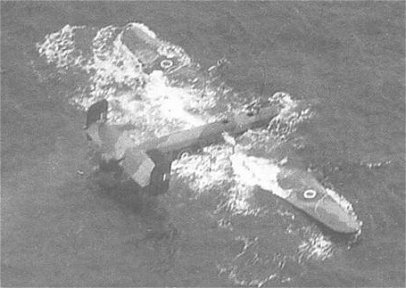
August 10/45 - Halifax LW170
rested on the surface seven hours before it’s descent to the ocean floor
off the North West coast of Ireland. (This might be the only picture of
a “floating” Hally.)
Halifax LW170 put in 24 Ops
with 424 Squadron between May 27/44 and August 4/44. Particulars of dates,
targets, and crewmembers, are listed on the 57 Rescue (Canada) Web site.
http://www,57rescuecanada.com
After the final operation
with 424 Squadron LW170 was sent away for major maintenance and engine
replacements. From here she was seconded to RAF Met squadron 518 and for
the next year flew long distance meteorological patrols. On August 10,
1945 while on a Bismuth weather sortie LW170 experienced a major fuel leak
and was unable to return to base. A text-book ditching was performed by
her crew at 9am and she floated for 7 hours, sinking into the deep at 4
P.M. Her crew were safely rescued 1 hour later by a banana freighter, the
Jamaica Producer.
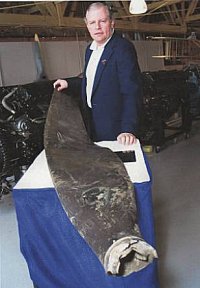
Karl Kjarsgaard,
Project Manager, 57 Rescue (Canada) with a prop blade from RCAF Halifax
LW682 which his recovery team saved from the bog in Belgium in 1997, along
with the bodies of the 3 missing airmen which were given a full military
funeral in Nov/1997.
(The following is an abridged
version of Karl’s report to those gathered at Nanton August 14, 2004, on
the proposed recovery Halifax LW170)
57 RESCUE (CANADA) August
14, 2004
Progress Report by Karl Kjarsgaard,
Project Manager
This is a special anniversary
day for this is the last day of the combat career of RCAF Halifax LW170
sixty years ago today. On August 4, 1944 Halifax LW 170 of 424 Squadron
RCAF participated in the bombing raid on Bois de Cassan and Trossy-St-Maxim,
V-1 flying bomb sites. There were 291 aircraft on this raid and the majority
of the heavy bombers involved were Halifaxes, 169 to be exact. Throughout
all the major air battles and campaigns where Canadian Squadrons and Allied
Squadrons fought the Halifax was always there.
Here we are setting out on
a most historic quest to find and recover RCAF Halifax LW170 thanks to
the sponsorship and partnership of the Nanton Lancaster Society.
“Press on regardless….”
On to Business – These are
the HALI-FACTS
To all of our member sand
supporters of 57 Rescue (Canada) for this special project I can report
good progress in certain areas and mediocre progress in others.
On the technical side I have
received a full evaluation of the search and rescue data from the original
LW170 ditching and crew rescue in August, 1945 which is critical to the
locating of the Halifax in the deep waters of NW Ireland. This was done
by Bob Kutzleb of Syracuse, New York, an exert in undersea location of
aircraft. His record recovery of several deep water recoveries is an US
Navy F-14 Tomcat from 9500 feet. Bob generously donated his time and energy
to construct the best search box to find Halifax LW170 and was pleased
with the historical positioning raw data provided to him by yours truly.
We have his full report and are ready to utilize his search criteria to
find LW170.
On another positive technical
development Dag Ammerud, the mastermind behind the lifting of Halifax NA337
from 750 feet in Lake Mjosa, Norway, has acquired new location technology
which could reduce the number of days searching for LW170
I am disappointed in the
progress on the financial end with regard to getting a corporate sponsor.
There have been several applications by 57 Rescue (Canada) to major corporations
in Alberta, Ontario, and Manitoba, but all declined to help sponsor this
historic project.
Our good neighbours and friends
in the U.S.A. are rallying to our cause. I have had memberships and donations
from them with the greatest support from Bob Bluford, a minister and B-24
Liberator pilot with the 8th Air Force. He pledged $1,000.00 in the name
of Mel Compton, the American in the RCAF who flew LW170 in June 1944, and
has challenged all new members and his fellow Americans to donate the same
in the name of an American in the RCAF who was killed in action. He is
well aware that these “American Patriots-Canadian Warriors” are not remembered
and there are over 700 US citizens killed in the service of the RCAF. Reverend
Bluford and I will be meeting soon in Richmond, Virginia to lobby for official
political and corporate support for our Halifax LW170 Project in the United
States. Will it be easier to find support for the RCAF Halifax Project
in the States than in Canada? I hope both nations will answer our calls
for help.
To all of you who have sent
cheques from all over Canada and the U.S.A. for memberships and donations
to our cause. Please be advised that I have NOT (as of August 14, 2004)
cashed your cheques as we are waiting for our charitable status to be confirmed.
I am presently paying for travel and promotional expenses from my own pocket.
We have over 100 Members now and have had almost 5000 visitors to the 57
Rescue (Canada) website. http://www.57rescuecanada.com
Ross
Hamilton
Six Sacks of Potatoes
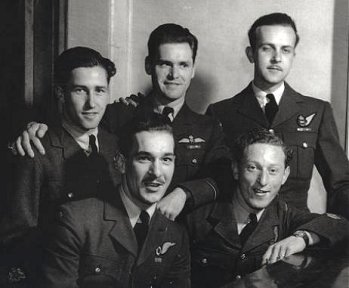
Back L to R – Grandy,
Biddle, Graham,
Front - Neil,
Firestone, (George Deeth, 2nd pilot not in picture)
September 25, 2004 marks
a special anniversary for a crew of 407 Squadron who crashed landed in
Norway sixty years ago.
The Germans had moved their
U-Boat operation from France to Norway. 407 Squadron whose crews had been
monitoring submarines in the English Channel, moved its base to Wick, Scotland.
During an anti-U-Boat patrol
over the North Sea one of their engines of the Leighlight-equipped Wellington
failed leaving the pilot, F/O Gordon Biddle with the only option, to reach
the nearest land-fall, German Occupied Norway.
As they approached the coast
they had to pass over a small enemy convoy and, with only one engine, had
little ability to take evasive action. The ships opened fire on the aircraft
and Harvey Firestone, attempting to confuse the gunners, fired off Very
lights hoping that they would think that they were a friendly aircraft.
This worked for a moment but they were soon under fire again. By now the
remaining engine had been hit and a final message was sent by the wireless
operator, Warrant Officer George Grandy, and everybody got ready for a
forced landing in their crash positions.
The pilot was attempting
to make a wheels-up landing in what appeared to be the only spot possible.
The Wellington hit some trees with its port wing and then Biddle brought
the tail down first to slow them up and then he jammed the nose in. The
aircraft slewed around and then came to a sudden stop - they had landed
in 65 feet. Grandy and the radio fell on the top of George Deeth, Neil
was thrown from his table and had a gash in his head, but Biddle was OK,
having been strapped in. Harvey Firestone hit his head on the main spar.
The crew were suddenly surrounded by Norwegian Resistance Fighters who
hurried them away from the crash site. They had crashed close to a German
garrison.
The Canadians were moved
from one safe hiding spot to another in the mountain regions. Subsequently
some of the Norwegian helpers were captured by the Germans and some were
shot. During this period of evasion, these brave Resistance Fighters shared
their meagre rations and faced death for their Canadian guests.
The Norwegian underground
had clandestine radio contact with the British and they code named the
407 crew “Six Sacks of Potatoes”. After some weeks as evaders, the crew
made their escape under the close supervision of the Resistance Fighters.
A rendezvous was established with great danger to all, with a British Motor
Torpedo Boat in the North Sea, and the six Canadians were returned to England.
After de-briefing at Air Force Head Quarters in London, five of the crew
were returned home to Canada for security reasons and not permitted to
return to flying duties in the UK.
A Plaque commemorating this
event and honouring the courage of the Resistance Fighters has been placed
on the site of the crash.
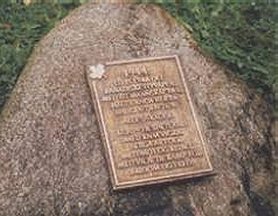
Text on Plaque
1944: An Aircraft from Canadian Air Force
with a crew of 6 crash landed here on the hill
the 26.9.
All uninjured.
12. 10 – to Shetland with KNM VIGGRA.
Rescued by people with courage and cunning,
with the will to fight for freedom and peace.
Fred Burnyeat
I was remembering my latter
days in the Air Force recently. As part of Coastal Command I was
stationed from the West Coast at Ukulet, to Shellborne, N. S. and in 1943
was transferred to #116 B & R which moved to Botwood, Newfoundland,
then to Gander and again to a posting to Eastern Air Command Headquarters
in Halifax. There were three other WAGS from this region, and all
4 of us had to keep 24 hour watch over the Signal Department. I was
on duty one night when this unusual thing happened and I think it would
be of interest to some of our group.
One of the girls who were
keeping watch on several frequencies, jumped up saying she had a MAY DAY,
MAY DAY, MAY DAY! I asked her if she had any other info and she said
her contact had told her he was a USAF pilot flying out of Maine, U.S.A.,
that he was completely lost and had no idea where to head for. I
phoned to the Plotting Department and they said that they had also heard
this and were plotting his flight. We were to keep him talking as much
as possible and they would send directions for him to follow. This
we did for 2 or 3 directions with the last one ending up that he was now
lined up with the main runway of Dartmouth airport. He was instructed to
change to their frequency and call them to identify himself for further
directions. We also told him that they were expecting him and would
see him down safely. A short time later the airport reported to our
plotters that he had landed OK.
The sequel to this is that
an hour or two later the Air Force guards on duty at the main doors of
our building phoned up to say that there was an American pilot at the door
saying we had saved his life and he would like to talk to the girl that
kept him posted and guided him in. I spoke to our girl and asked
if she wanted to meet him and she was agreeable so I released her to go
down to the front door. She returned shortly and was so happy she
had met him. He was so thankful for her help that he then handed her a
box of chocolates he must have purchased on his trip from Dartmouth to
Halifax.
Ed. It is not
outside the realm of possibility that the above mentioned USAF pilot might
read this article. If you are still out there my friend, drop me a line.
moyles@sasktel.net
Pictures
from Nanton Musium August 14th
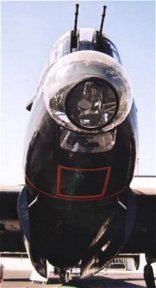
Nose of Lanc.
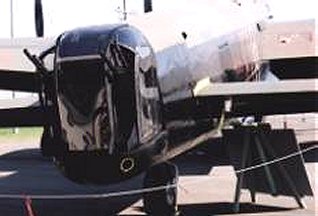
Rear Gunner’s office
in tail of Lanc
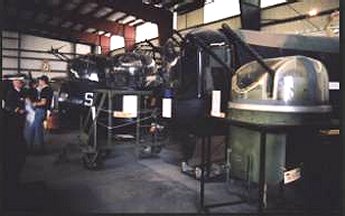
Museum’s turret display.
Tail turret second from
Right is equipped with
hydraulics and is functional.
CLIFFORD
CAMPBELL – Dunchurch, Ont.
A Rear Gunner looks back
after Sixty years
During 1944 I made 37 trips
over Germany, Belgium, and France, transportation being provided by the
RCAF in what became known as “Halibags”, Halifax bombers operating out
of Canadian Six Group and stationed at Tholthorpe, Yorkshire. Our crew
were members of #420 “Snowy Owl” Squadron and shared the aerodrome with
#425 Squadron better known as the “Alouettes”.
I write this piece in honour
of Pilot Officer (then Sergeant) Bob “Whitey” White DFC, who was the designated
mid-upper gunner in the crew in which I was the rear gunner, although at
various times he and I would exchange positions. Our Captain was Warrant
Officer Bill McAdam, DFC.
Bob White was very keen and
very sharp. My recollections of him here begin with a part of his personal
story, which he shared with me in answer to my question about some prominent
scars on his left forearm. Bob lived in the West Midlands, and while still
too young to join the RAF, endured an enemy bombing in which he sustained
the injuries but, nonetheless, crawled under a shattered building to rescue,
from the arms of her dead mother, a baby girl whom he kept track of for
the rest of his life (Bob passed away in 1995.
On May 27, 1944, we were
assigned to bomb Bourg Leopold in Belgium. On the way out to the target
area the German fighters were both present and busy and I personally witnessed
a total of nine of our aircraft go down. In one case, the fighter must
have followed his victim’s descent, for I could see tracer bullets pouring
out of the bomber’s rear turret right until the bomber hit the ground and
disintegrated in a ball of flame.
About five minutes after
we had made our drop and headed for home our mid-upper turret burst into
action. My turret was facing directly to the rear and before I could swing
to starboard it was all over, but I did manage a glimpse. It seems the
JU 88 had made a 90 degree turn towards us on our starboard beam. The gunner’s
response to that move is a “no deflection” shot. What I could not see,
Whitey and the co-pilot (Bombardier) could. What they reported at the later
debriefing was this. “The Junkers starboard engine burst into flame and
then a piece of the tail section flew off.” I saw him wiz by behind us
and that was it. How badly he was damaged we shall never know, but we escaped!
The following month on June
12/44, our target was Cambria in France, and the drop zone was lit up like
a Christmas tree. On our way out of the target I clearly saw and reported
the presence of a Focke-Wulf 190, whose nose was painted white. The fighter
flew West to East right through the illuminated area. We subsequently altered
course and headed North West for the English Channel. About half way there,
the mid-upper turret once again came to life, and while I was again out
of position I saw the tracer from Whitey’s guns over my left shoulder.
The German had fired his first burst just above his target. Whitey’s response
must have spooked him into making a steep bank to his port side . Since
he had come in from the starboard beam his subsequent bank exposed his
belly to a fusillade of ammo, and I could see our tracer actually bouncing
off his underside! We had been told that the 190 had a protective lead
shield and here was proof enough; but its effect was to make us feel as
if we were fighting a war with popguns. However, I can imagine the German
pilot could hear the multiple thuds in his cockpit, and if he reached home
safely that night, I guarantee he had to change his underwear!
Bob White went on to join
the Pathfinder Squadron after he completed his tour with us and finally
did receive his well deserved Distinguished Flying Cross.
It is a matter of interest
that the Cambria raid referred to above was the same raid during which
Air Gunner Andrew Mynarski, VC, lost this life in a heroic attempt to save
that of a fellow crew member, following an attack by a JU 88. I suppose
every age has its heroes. We certainly had ours!
(Ed. Following
the war Clifford Campbell became an ordained minister in the United Church
of Canada retiring at Dunchurch, Ontario.)
Proposed
Nanton Museum Memorial to Bomber Command
Letter from Ted Hackett
Good evening John.
Here is the message I sent
to Nanton and their reply. I guess you just have download the whole thing
and put it in to the next Newsletter. I went into the web site he
gave us and the whole thing is laid out there...probably the one to print.
Cheers Ted.
From Ted Hackett to Dave
Birrell, Nanton Museum.
Good afternoon Dave.
I was talking to my MLA
the other day and the discussion got around to the humungous amount of
money the government has to give away. The subject of the Museum
and the Lancaster came up, he said that he had never visited but he had
heard of the Museum. I suggested that the memorial to the Canadians
who died while serving with Bomber Command deserved some financial help.
It would make a nice birthday present. He told me of the many programmes
that are available for such things and that they were a 50-50 deal.
I contacted John Moyles, who puts together our newsletter "Short Bursts"
each month and suggested that we start a campaign among our members to
help raise money for that project. He thinks that is a good idea
and he wants me to write something up for inclusion in the October issue.
Could you send me some information on the planned memorial and, if possible
a copy of that drawing of the memorial. I believe there was a picture of
the planned memorial in one of the latest issues of your newsletter but
I believe it is the one I sent to a friend in New Zealand. Any assistance
you can give me would be much appreciated.
Thanks and have a nice day(it
is miserable here!)
Ted.
From Dave Birrell to Ted
Hackett
Hi Ted:
Thanks for your note and
enthusiasm for the project.
A complete summary of the
project is available on our website at http://www.lancastermuseum.ca/memorialgranite.html
and of course you may copy
the artist's rendering of the Memorial and anything else you'd like from
there.
I've also attached an jpg
of the Memorial rendering and a WORD file summarizing the project for your
use. Any assistance with financing would be wonderful. You can tell people
that the majority of the funding required has already been acquired through
private donations.
Thanks for passing along
your recent newsletter with the write up and photos of our "Salute to the
Air Gunners." I'll pass them along to others here. It was a great day.
Please keep in touch and
let me know if we can assist you in your efforts to assist us. . .
So long for now,
Dave.
Canada's
Bomber Command Memorial
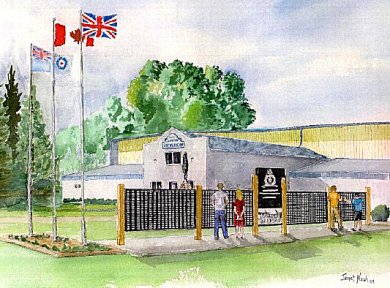
Ten Thousand Names
[ from F/L Karl Aalborg
to F/O James Zunti ]
The Nanton Lancaster Air
Museum is the only facility in Canada whose primary goal is to honour those
who served with Bomber Command. To this end, the museum will create a Memorial
that will list the name of every Canadian who was killed while serving
with Bomber Command. The Memorial, with the 10,465 engraved names, will
be unveiled at a special event during August, 2005, the year that will
mark the sixtieth anniversary of the end of the war.
Letter from Ted Hackett
to Editor
John, I got to thinking (there's
a first) after I sent you the message about the memorial that perhaps,
instead of contributing to the memorial, we should aim for some individual
item. I was thinking of a short path leading from in front of the memorial
to a couple of nice benches with perhaps a planter in between and a small
plaque to read " These benches placed here by the ex-Air gunners
and Wireless air gunners Association of Canada in memory of etc.,
etc." It would be a spot where visitors could sit and admire the memorial.
It certainly shouldn't be too expensive and would be an AG/WAG thing instead
of our contribution being lost in the larger one. What do you
think??
This is the type of bench
that I had in mind. The City of Spruce Grove has them and so does Edmonton.
They are made by a firm called Expocrete, I'm going to contact them and
see how much they cost.
Ted.
(Ed. We would
like some feedback on Ted’s suggestion. Send you opinions and constructive
criticism to your Short Bursts Editor – address follows the Editor’s Report
or, contact Ted direct:
Ted Hackett
47 Dorchester Rd.,
Spruce Grove, AB T7X 2B5
Ph. (780) 962-2904
tedgene@telusplanet.net
CORRESPONDENCE
Evening John.
I don't know if Dave Rodger
was a member or not but I thought it might be of interest to some of our
people and the notice might fill up a space in Short bursts. I met
Paul Morley last year in Lake Louise, he is from Hamilton and like me is
a train watcher. Gene and I were parked by the CP tracks and he saw
my AG licence plate and came over to talk. He was on his way to Nanton
to give them some items of his Uncle who was a member of 617. We have kept
in touch during this past year, nice young man. Cheers,Ted
From: Paul Morley
To: Ted & Gene
Sent: Tuesday, September
07, 2004 7:53 PM
Subject: Dave Rodger
Dear Ted:
One of your brother gunners
has passed away. Dave was the Gunnery Officer of the Dambusters. I met
him last year in Sault Ste. Marie. He had skin cancer and Alzheimers.
Even though he was sick he had a twinkle in his eye, and was very pleasant
to talk to. He flew with Joe McCarthy. There are only 2 Dambusters left
in Canada. There is one in New Zealand, and I believe two in England.
Please pass this on to your
friends.
Thanks,
Paul
Letter from Niels Reynolds
in the UK
I've just been browsing your
wonderful site and was hoping you may be able to help.
My father trained in Canada
on Liberator bombers as a tail end gunner in 1942, then acted as a trainer
himself until 1943/44, after which he saw action in Indo China - Digri
and Kolar are noted on some of his photos.
His name is Percy Charles
Reynolds, born in Denmark 1922.
He is alive and well and
looking to make contact with old comrades. If there is any help you can
offer, I would be extremely grateful!
Incidentally, I also have
an obscure Canadian link - I now live in the house which was used by the
Canadian Army HQ prior to the Normandy D-Day landings, in Crowborough,
East Sussex.
I look forward to hearing
from you.
Kindest Regards,
Niels Reynolds
niels@powdermill.plus.com
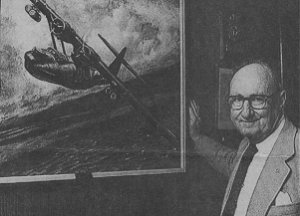
The late Leonard Birchall
D.F.C. with a picture
of a long range Catalina
Flying Boat
THE SAVIOUR OF CEYLON
It is 62 years since a 27
year old Canadian Pilot and his crew lifted off from a makeshift air base
in Sri Lanka (Ceylon) to forestall what Winston Churchill said was the
most perilous moment in the second world war.
In 1942 Leonard Birchall,
who passed away Sept. 10, 2004, in Kingston, Ont. at age 89, and his crew,
Bart Onyette, Brian Catlin, Ginger Cook, J. Henzell, Ian Davidson, P.O.
Kennedy, L.A. Colarossi, and radio operator Fred Phillips, took off from
their base at Koggala, Ceylon, at dawn on April 4, 1942 in Catalina AJ-155.
They were furnished with hand drawn charts. In the late afternoon, after
having been in the air for 12 hours they discovered that the inaccurate
charts had probably caused them to fly 450 kilometres off course. It was
an extraordinary stroke of serendipity for almost at the end of the last
leg of the patrol the crew saw something far to the South.
They had just finished a
snack when they saw some specks which looked like a convoy and they went
over to investigate. They identified the outer screen of the Japanese fleet
and radioed back to base the position, course, speed, and composition of
the fleet. On closer inspection they identified battleships, several aircraft
carriers, and other war ships which Fred Phillips reported back to base.
Then all hell broke loose.
30 Zeros came at them from the carriers. The Catalina was hit in the fuel
tank and erupted in flames. Birchall managed to ditch the aircraft but
it sank immediately killing one of the crew. The remainder swam away from
the burning gas that spread out over the water. However, the Japanese fighters
machined gunned the crew in the water. Two more crewmembers were killed
and Birchall was hit in the leg.
The remaining crew members
were picked up by a Destroyer and interrogated. When asked if they got
a message out to base they said no because their radio had been shot out.
This seemed to satisfy their captors until the Japanese intercepted a radio
signal from Colombo to the aircraft asking them to repeat their previous
message. Birchall was severely beaten. It was his first taste of mistreatment.
It wasn’t until after release from PoW camp that they found out their first
message did get through.
As a result of the sighting
the Royal Navy sent its Ceylon fleet to sea and the RAF were in a position
to repulse the enemy aircraft when the Japanese dropped their bombs on
Colombo on April 5/42. The Japanese withdrew its large attack force from
the Indian Ocean and abandoned plans to invade India by way of Ceylon.
Churchill, in 1945 said,
“the sighting of the Japanese fleet had adverted the most dangerous and
distressing moment of the entire conflict. Ceylon’s capture, the consequent
control of the Indian Ocean and the possibility of a German conquest in
Egypt would have closed the ring, and the future would have been bleak.”
In the Japanese prisoner
of war camp 150 kilometres West of Tokyo, Birchall became the advocate
for and defender of the men, resulting in him being condemned to death
three times. He kept secret documentation of the atrocities witnessed in
the camp. In 1948 Birchall returned to Japan to testify in the subsequent
war trials and witness the hanging of one of his former tormenters. Years
later he used his diaries to in a campaign to win Federal compensation
for PoW survivors. Some of his documents were used by Barry McIntosh in
his book HELL ON EARTH.
Two days after Leonard Birchall
passed away, Fred Phillips, the radio operator, and fellow camp survivor,
died at his home in England. Of the AJ 155 crew, only Mr. Catlin is still
living.
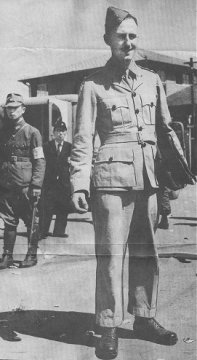
1945 - Leonard Birchall
clad in hand-me-downs,
leaving PoW camp with
diary notes
A
FEW MORE PICTURES FROM AUGUST 14th AT NANTON
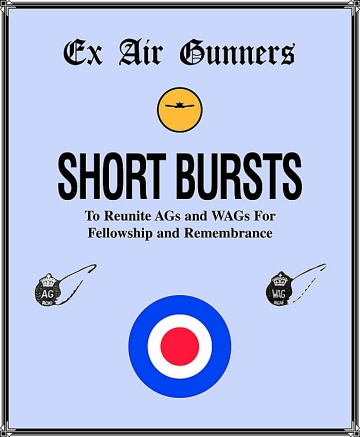








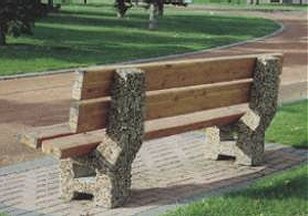
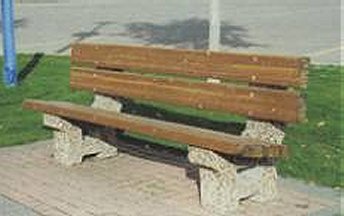


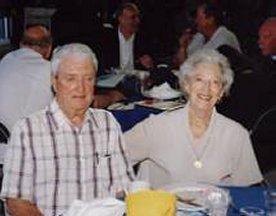
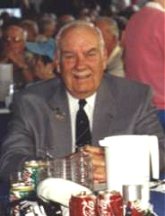
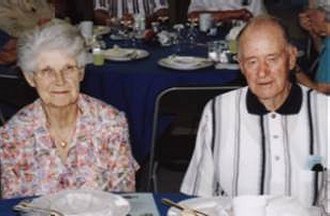
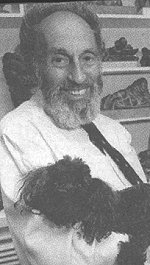 Morris
Shumiatcher , Mbr. #637 Regina, Sk. (1917 – September 23, 2004). Morris
had already obtained a Masters degree in Law before he joined the RCAF
in 1943 to train as an Air Gunner. He took his training at #9 B&G Mont
Joli and upon graduation was designated as a Gunnery Instructor.
When the fledgling C.C.F government gained power in Saskatchewan under
Premier Tommy Douglas in 1945, Tommy seconded Morris to become the Law
Officer of the Attorney General and Personal Assistant to the Premier.
At the age of 31 Morris became the youngest King’s Council in the Commonwealth.
He prepared and sponsored the Saskatchewan Bill of Rights which was the
first such legislation in Canada and two years prior to the United Nations
legislation. In 1946 Morris convened the first meeting of Treaty Indians
and published a text of their treaties. So concerned with the plight of
the aboriginal community, in 1971 he wrote Welfare: Hidden Backlash. He
practiced law in Regina until retirement, and was a prominent contributor
to his community.
Morris
Shumiatcher , Mbr. #637 Regina, Sk. (1917 – September 23, 2004). Morris
had already obtained a Masters degree in Law before he joined the RCAF
in 1943 to train as an Air Gunner. He took his training at #9 B&G Mont
Joli and upon graduation was designated as a Gunnery Instructor.
When the fledgling C.C.F government gained power in Saskatchewan under
Premier Tommy Douglas in 1945, Tommy seconded Morris to become the Law
Officer of the Attorney General and Personal Assistant to the Premier.
At the age of 31 Morris became the youngest King’s Council in the Commonwealth.
He prepared and sponsored the Saskatchewan Bill of Rights which was the
first such legislation in Canada and two years prior to the United Nations
legislation. In 1946 Morris convened the first meeting of Treaty Indians
and published a text of their treaties. So concerned with the plight of
the aboriginal community, in 1971 he wrote Welfare: Hidden Backlash. He
practiced law in Regina until retirement, and was a prominent contributor
to his community.
